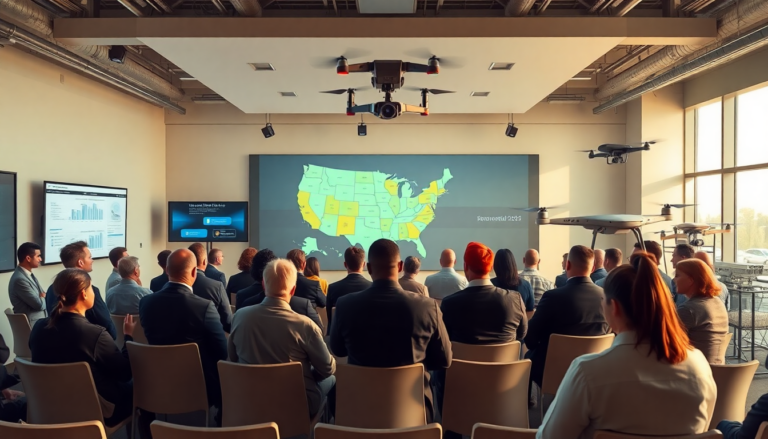Argomenti trattati
In the rapidly evolving landscape of drone technology, the annual XPONENTIAL 2025 conference has emerged as a pivotal event. With over 7,500 industry leaders and users in attendance, the discourse surrounding U.S. drone policy and national security has never been more critical. A panel discussion titled ‘The High Stakes Debate: Security and the Future of Innovation’ highlighted the pressing issues regarding federal efforts to curb Chinese drone technologies and the broader implications for the domestic drone ecosystem. The question on everyone’s mind: Is the U.S. truly prepared to meet its own ambitious expectations in this domain?
Current challenges in U.S. drone policy
Industry expert Mike Walsh, a partner at DLA Piper specializing in national security trade law, kicked off the panel with an unflinching overview of the ongoing technology war with China. “We are obviously in a technology war with China,” he asserted. Walsh emphasized the current U.S. policy framework aimed at safeguarding domestic innovation while preventing adversaries from accessing high-tech systems. It’s a complex dance, utilizing tools like tariffs, export controls, and incentives to effectively “China-proof” U.S. businesses. Yet, as he pointed out, these measures come with their own set of challenges.
According to Walsh, the enforcement of export controls has ramped up significantly, with the Department of Commerce zeroing in on major violations. “Companies that should have known better are facing fines in the hundreds of millions,” he remarked, advocating for companies to establish internal compliance policies. The stakes are high, and preparedness is essential—especially when the consequences of non-compliance can be severe.
The impact on public safety agencies
The conversation took a turn when Brendan Schulman, the panel moderator and VP of Policy at Boston Dynamics, posed a critical question: How many attendees have already been forced to change their drone operations due to policy? The response was telling—only a handful of hands went up, indicating that the ramifications of these policies are still taking shape. Nevertheless, there was a palpable sense of urgency among the panelists about the mounting pressure on public safety agencies.
Matt Sloane, Co-Founder and Chief Strategy Officer at SkyfireAI, articulated the predicament public safety officials face. “There’s a real fear that they aren’t going to have the tools they need,” he stated, highlighting the potential operational paralysis for agencies reliant on Chinese-made drones during emergencies. “We all want to use U.S. drones… but right now we’re in this awkward teenage phase,” Sloane quipped, capturing the industry’s current state of uncertainty.
It’s a tough spot. U.S.-made alternatives often don’t match the price point or functionality of their Chinese counterparts. Without adequate funding or governmental support, public agencies and smaller commercial users find themselves in a precarious limbo, waiting for a favorable shift.
Building a secure supply chain
As the panelists discussed potential strategies for navigating this turbulent landscape, Joel Roberson from Holland & Knight LLP stressed the importance of intentionally designing supply chains with current regulations and anticipated restrictions in mind. He noted that technologies like LiDAR are under increasing scrutiny, suggesting that companies must be proactive in adapting to this evolving regulatory framework.
Moreover, Matt Beckwith, VP of Policy at Guardian Agriculture, pointed out that legislative changes such as NDAA Section 817 and Section 889 have started to resonate with investors, hinting at a shift in the market dynamics. “We’re starting to see that message resonate, and it’s beginning to pay off,” he remarked, optimistic about emerging supply chain partnerships with automotive manufacturers.
The call for political will and investment
Yet, the challenges persist. Todd Graetz, CEO of Aerolane, voiced a critical need for more than just funding—he called for political will. “We need the capital and the leadership to go to U.S. drone manufacturers and say: ‘Go build. We’ll remove the red tape,’” he insisted, highlighting the urgency of action from the government. In a moment of stark realism, Matt Joyner from Ghost Robotics pointed out a chilling vulnerability: “If we go to war tomorrow, we have a 30-day supply of batteries. That’s scary as hell.” These realities underscore the need for manufacturing infrastructure to become a national priority.
The conversation took an intriguing turn when Joyner shared that despite the risks, his company had secured investment through a Korean partner. This reflects not only international interest but also the burgeoning demand for ground robotics in Asia. “We need a Sovereign Wealth Fund in the United States,” Joyner advocated, calling for strategic, long-term investments to bolster the domestic drone industry.
Innovative paths forward
As the panel discussion wrapped up, the experts were posed with a provocative question: What single change could smooth the transition away from reliance on Chinese technology? Sloane was quick to respond: “Grants. We need money to buy alternatives.” There was a consensus that U.S. policy needs to evolve beyond simple bans. Schulman, reflecting on his previous experience at DJI, noted that technical and policy-based solutions could strike a balance between protecting innovation and ensuring public safety operations remain unharmed.
Roberson concluded with an appeal for greater community engagement: “From a policy perspective, the community needs to engage in the process. The federal government is looking at this from the perspective that you’re either with us or against us.” This call to action resonates deeply in the current climate, highlighting the urgent need for collaboration between industry stakeholders and policymakers.
As the discussions at XPONENTIAL 2025 made clear, the tension at the heart of U.S. drone policy is palpable. Finding a way to secure national interests while fostering innovation and critical services is a delicate balancing act. Until scalable, affordable, and fully functional U.S.-made alternatives are available, navigating these complexities will remain a formidable challenge for all involved.

